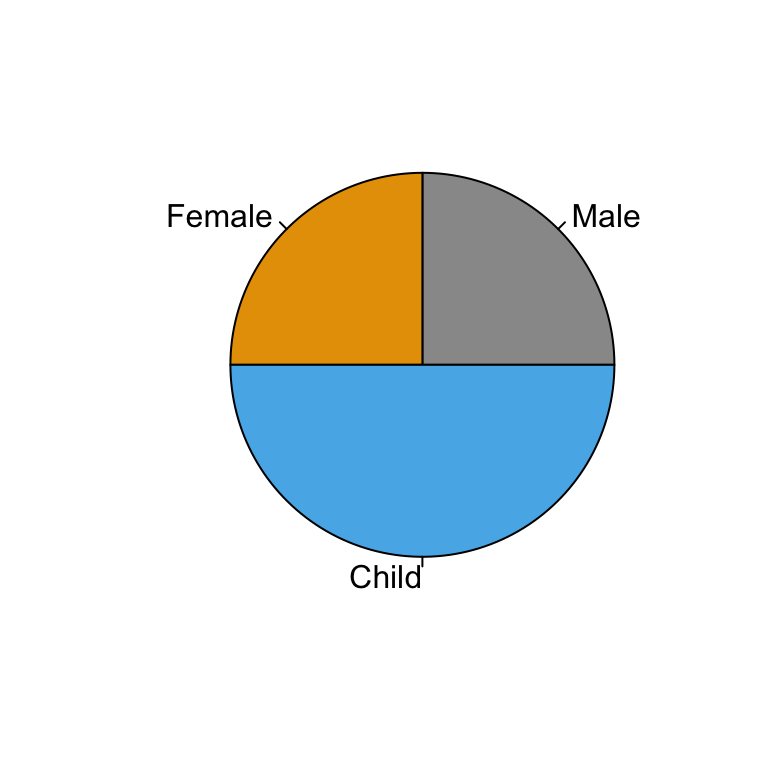Pie Charts - R Base Graphs
Previously, we described the essentials of R programming and provided quick start guides for importing data into R.
Pleleminary tasks
Launch RStudio as described here: Running RStudio and setting up your working directory
Prepare your data as described here: Best practices for preparing your data and save it in an external .txt tab or .csv files
Import your data into R as described here: Fast reading of data from txt|csv files into R: readr package.
Create some data
df <- data.frame(
group = c("Male", "Female", "Child"),
value = c(25, 25, 50)
)
df## group value
## 1 Male 25
## 2 Female 25
## 3 Child 50Create basic pie charts: pie()
The function pie() can be used to draw a pie chart.
pie(x, labels = names(x), radius = 0.8)- x: a vector of non-negative numerical quantities. The values in x are displayed as the areas of pie slices.
- labels: character strings giving names for the slices.
- radius: radius of the pie circle. If the character strings labeling the slices are long it may be necessary to use a smaller radius.
pie(df$value, labels = df$group, radius = 1)
# Change colors
pie(df$value, labels = df$group, radius = 1,
col = c("#999999", "#E69F00", "#56B4E9"))
Create 3D pie charts: plotix::pie3D()
Te function pie3D()[in plotrix package] can be used to draw a 3D pie chart.
Install plotrix package:
install.packages("plotrix")Use pie3D():
# 3D pie chart
library("plotrix")
pie3D(df$value, labels = df$group, radius = 1.5,
col = c("#999999", "#E69F00", "#56B4E9"))
# Explode the pie chart
pie3D(df$value, labels = df$group, radius = 1.5,
col = c("#999999", "#E69F00", "#56B4E9"),
explode = 0.1)
See also
Infos
This analysis has been performed using R statistical software (ver. 3.2.4).
Show me some love with the like buttons below... Thank you and please don't forget to share and comment below!!
Montrez-moi un peu d'amour avec les like ci-dessous ... Merci et n'oubliez pas, s'il vous plaît, de partager et de commenter ci-dessous!
Recommended for You!
Recommended for you
This section contains the best data science and self-development resources to help you on your path.
Books - Data Science
Our Books
- Practical Guide to Cluster Analysis in R by A. Kassambara (Datanovia)
- Practical Guide To Principal Component Methods in R by A. Kassambara (Datanovia)
- Machine Learning Essentials: Practical Guide in R by A. Kassambara (Datanovia)
- R Graphics Essentials for Great Data Visualization by A. Kassambara (Datanovia)
- GGPlot2 Essentials for Great Data Visualization in R by A. Kassambara (Datanovia)
- Network Analysis and Visualization in R by A. Kassambara (Datanovia)
- Practical Statistics in R for Comparing Groups: Numerical Variables by A. Kassambara (Datanovia)
- Inter-Rater Reliability Essentials: Practical Guide in R by A. Kassambara (Datanovia)
Others
- R for Data Science: Import, Tidy, Transform, Visualize, and Model Data by Hadley Wickham & Garrett Grolemund
- Hands-On Machine Learning with Scikit-Learn, Keras, and TensorFlow: Concepts, Tools, and Techniques to Build Intelligent Systems by Aurelien Géron
- Practical Statistics for Data Scientists: 50 Essential Concepts by Peter Bruce & Andrew Bruce
- Hands-On Programming with R: Write Your Own Functions And Simulations by Garrett Grolemund & Hadley Wickham
- An Introduction to Statistical Learning: with Applications in R by Gareth James et al.
- Deep Learning with R by François Chollet & J.J. Allaire
- Deep Learning with Python by François Chollet
Click to follow us on Facebook :
Comment this article by clicking on "Discussion" button (top-right position of this page)







